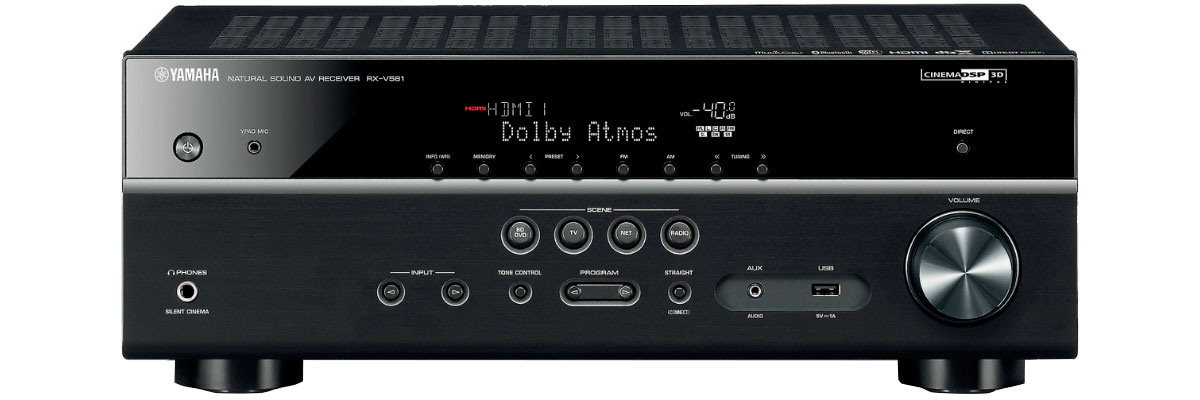 Home-theater systems continue to conquer object-oriented formats - after running-in technologies on receivers of the upper price segment, more affordable models began to acquire Dolby Atmos and DTS: X support. As new technologies become available to a wide range of moviegoers, consider the example of the classic Yamaha RX-V581 specs - the representative of the 2016 Yamaha line. More info in this Yamaha RX-V581 review.
Home-theater systems continue to conquer object-oriented formats - after running-in technologies on receivers of the upper price segment, more affordable models began to acquire Dolby Atmos and DTS: X support. As new technologies become available to a wide range of moviegoers, consider the example of the classic Yamaha RX-V581 specs - the representative of the 2016 Yamaha line. More info in this Yamaha RX-V581 review.
Yamaha RX-V581 review
Features
Unlike the two younger five-channel counterparts with indices 381 and 481, the RX-V581 has seven amplification channels, which, in fact, determined its status as the most inexpensive Yamaha receiver with support for Dolby Atmos and DTS: X. Its power is 115W (6 ohms). Another extremely important feature is full compatibility with the MusicCast proprietary wireless multiroom platform.
Design and build
The receiver looks solid and attractive. The upper part of the front panel is mirror-polished, which visually increases the display area, and the overall dimensions of this small (in comparison with classmates of other brands) apparatus. In full accordance with the price hierarchy, the facade and the large volume knob are made of plastic. Actually, on the front side there are only connectors for a calibration microphone, headphones, an analog stereo line-in and a USB port. There is no hinged lid hiding additional connectors and controls. In general, the RX-V581 switching kit does not indulge in excesses, but everything really needed is available.

Connectivity
On the rear panel there are four inputs and one HDMI output, which, according to current concepts, is, frankly, end-to-end. As for wireless switching, it is represented by Bluetooth and Wi-Fi modules, the latter working exclusively in the 2.4 GHz band.
Setup
However, the arising intricacies of acoustic waves can be more or less adequately resolved using automatic calibration only. To do this, the RX-V581 has YPAO - perhaps one of the best acoustic optimization systems in home cinema. She is able to build an adequate profile, even for a room of complex shape, and with an environment full of reflective surfaces.
Pros and Cons
Pros
- Readiness to work with Ultra HD Blu-ray players
- Rich network capabilities and support for MusicCast technology
- High-quality sound processing
Cons
- Lack of multi-channel analog output and HDMI port on the front of the device
Common features
Product
Model
Brand
Reviews
Amplifier
Channels
Stereo power (RMS), W/Ohm
Output impedance, Ohm
Frequency response
THD in stereo, %
Audio features
Digital to analog converter (DAC)
Bi-amping
Pure direct (straight)
Auto speaker calibration
Speaker A/B switching
Other audio features
Connectivity
Wi-Fi
USB
Bluetooth
Ethernet (RJ45)
DLNA
MHL
Streaming services
Apple Music (AirPlay)
Amazon Music
Spotify
Other streaming services
Extensive connection
HDMI input/output
HDMI ARC (Audio Return Channel)
HDMI eARC (Enhanced Audio Return Channel)
HDMI CEC
Digital content protection (HDCP)
Subwoofer output (LFE)
Headphone output
Optical digital input
Coaxial digital input
Composite input
Component input/output
Phono (MM) input
Front panel connectors
Multi channel preamp output
Video features
HDR (High Dynamic Range)
4K signal pass-through
8K signal pass-through
HDMI signal pass-through
3D signal pass-through
HDMI pass-through in standby mode
Video conversion
Analog to HDMI scaling
HDMI to HDMI scaling
Dolby Vision
Other video features
Additional features
Voice control
App control
Display
Tuner
Sleep timer
Auto power off
ECO mode
Graphical user interface (GUI)
Setup assistant
Firmware update
Other additional features
Multi-room
Multi-room zones
Zone audio output
Zone HDMI output
Multi-room control
RS-232
Remote control input/output (IR)
DC trigger output (12V)
Multichannel surround
Dolby Atmos
Dolby TrueHD
Dolby Surround
Dolby (other)
DTS:X
DTS HD Master
DTS Virtual:X
DTS Neural:X
DTS (other)
Auro-3D
IMAX Enhanced
Multichannel stereo
Audio file formats
MP3
WMA
AAC
WAV
FLAC
ALAC
Other audio file formats
Power
Operational power consumption, W
Standby consumption, W
Removable power cord
User manual
Manual
Dimensions
Size W x H x D, cm/inches
Weight, kg/lbs
Other
Release year


